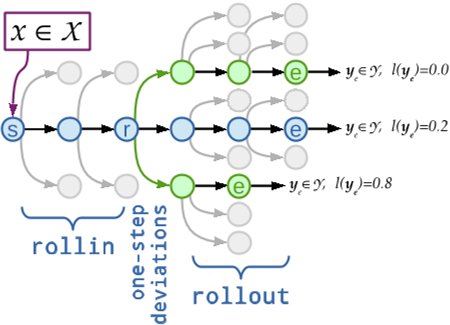Imitation learning
Imitation learning for part-of-speech tagging¶
| I | can | fly |
|---|---|---|
| Pronoun | Modal | Verb |
Task loss: Hamming loss: number of incorrectly predicted tags
Transition system: Tag each token left-to-right
Expert policy: Return the next tag from the gold standard
Gold standard in search space
paths = [[],[(0,4),(1,3)],[(0,4),(1,3),(2,2)],[(0,4),(1,3),(2,2),(3,1)]]
rows = ['Noun', 'Verb', 'Modal', 'Pronoun','NULL']
columns = ['NULL','I', 'can', 'fly']
cbs = []
for path in paths:
cbs.append(cg.draw_cost_breakdown(rows, columns, path))
util.Carousel(cbs)
- Three actions to complete the output
- Expert policy replicates the gold standard
Training a classifier with structure features
gold_path = [(0,4),(1,3),(2,2),(3,1)]
cb_gold = cg.draw_cost_breakdown(rows, columns, gold_path)
cb_gold
| timestep | label ($\alpha_t$) | features ($\phi(S_{t-1},\mathbf{x})$) |
|---|---|---|
| $t=1$ | Pronoun | token=I, ..., prev=NULL |
| $t=2$ | Modal | token=can, ..., prev=Pronoun |
| $t=3$ | Verb | token=fly, ..., prev=Modal |
Algorithm¶
\begin{align} & \textbf{Input:} \; D_{train} = \{(\mathbf{x}^1,\mathbf{y}^1)...(\mathbf{x}^M,\mathbf{y}^M)\}, \; \text{expert}\; \pi^{\star}, \; \text{classifier} \; H\\ & \text{set training examples}\; \cal E = \emptyset\\ & \mathbf{for} \; (\mathbf{x},\mathbf{y}) \in D_{train} \; \mathbf{do}\\ & \quad \text{generate expert trajectory} \; \alpha_1^{\star}\dots \alpha_T^{\star} = \pi^{\star}(\mathbf{x},\mathbf{y})\\ & \quad \mathbf{for} \; \alpha^{\star}_t \in \alpha_1^{\star}\dots \alpha_T^{\star} \; \mathbf{do}\\ & \quad \quad \text{extract features}\; \mathit{feat}=\phi(\mathbf{x},S_{t-1}) \\ & \quad \quad \cal E = \cal E \cup (\mathit{feat},\alpha^{\star}_t)\\ & \text{learn} \; H\; \text{from}\; \cal E\\ \end{align}
With logistic regression and $k$ previous tags: training a $kth$-order Maximum Entropy Markov Model (McCallum et al., 2000)
Exposure bias¶
wrong_path = [(0,4),(1,3),(2,1)]
cb_wrong = cg.draw_cost_breakdown(rows, columns, wrong_path)
util.Carousel([cb_gold, cb_wrong])
We had seen:
| timestep | label | features |
|---|---|---|
| t=3 | Verb | token=fly,..., prev=Modal |
but not:
| timestep | label | features |
|---|---|---|
| t=3 | Verb | token=fly,..., prev=Verb |
Define a rollin policy that sometimes uses the expert $\pi^{\star}$ and other times the classifier $H$:
$$\pi^{in} = \beta\pi^{\star} + (1-\beta)H$$DAgger algorithm¶
\begin{align} & \textbf{Input:} \; D_{train} = \{(\mathbf{x}^1,\mathbf{y}^1)...(\mathbf{x}^M,\mathbf{y}^M)\}, \; \text{expert}\; \pi^{\star}, \; \text{classifier} \; H\\ & \text{set training examples}\; \cal E = \emptyset ,\; \color{red}{\pi^{\star}\; \mathrm{probability}\; \beta=1}\\ & \mathbf{while}\; \text{termination condition not reached}\; \mathbf{do}\\ & \quad \color{red}{\text{set rollin policy} \; \pi^{in} = \beta\pi^{\star} + (1-\beta)H}\\ & \quad \mathbf{for} \; (\mathbf{x},\mathbf{y}) \in D_{train} \; \mathbf{do}\\ & \quad \quad \color{red}{\text{generate trajectory} \; \hat \alpha_1\dots\hat \alpha_T = \pi^{in}(\mathbf{x},\mathbf{y})}\\ & \quad \quad \mathbf{for} \; \hat \alpha_t \in \hat \alpha_1\dots\hat \alpha_T \; \mathbf{do}\\ & \quad \quad \quad \color{red}{\text{ask expert for best action}\; \alpha^{\star} = \pi^{\star}(\mathbf{x},S_{t-1})} \\ & \quad \quad \quad \text{extract features} \; \mathit{feat}=\phi(\mathbf{x},S_{t-1}) \\ & \quad \quad \quad \cal E = \cal E \cup (\mathit{feat},\alpha^{\star})\\ & \quad \text{learn}\; H \; \text{from}\; \cal E\\ & \quad \color{red}{\text{decrease} \; \beta}\\ \end{align}
Proposed by Ross et al. (2011) motivated by robotics
- first iteration is standard classification training
- task loss and gold standard are implicitly considered via the expert
- DAgger: the Datasets in each iteration are Aggregated
rollins expose to previous mistakes. Future ones?
rollouts: expose the classifier to future mistakes!
Training labels as costs¶
cb_gold
| timestep | Pronoun | Modal | Verb | Noun | features |
|---|---|---|---|---|---|
| t=1 | 0 | 1 | 1 | 1 | token=I, prev=NULL... |
| t=2 | 1 | 0 | 1 | 1 | token=can, prev=Pronoun... |
| t=3 | 1 | 1 | 0 | 1 | token=fly, prev=Modal... |
Cost break down
p = gold_path.copy()
cost = 1
cb_costs = []
cb_costs.append(cg.draw_cost_breakdown(rows, columns, [(0,4),(1,3)], roll_in_cell=p[1]))
cb_costs.append(cg.draw_cost_breakdown(rows, columns, [(0,4),(1,3),(2,0)], roll_in_cell=p[1], explore_cell=(2,0)))
cb_costs.append(cg.draw_cost_breakdown(rows, columns, [(0,4),(1,3),(2,0),(3,1)], roll_in_cell=p[1], explore_cell=(2,0),roll_out_cell=(3,0)))
cb_costs.append(cg.draw_cost_breakdown(rows, columns, [(0,4),(1,3),(2,0),(3,1)], cost, p[3], roll_in_cell=p[1], explore_cell=(2,0),roll_out_cell=(3,0)))
for i in range(1,4):
p = gold_path.copy()
p[2] = (gold_path[2][0],i)
if p == gold_path:
cost = 0
else:
cost = 1
cb_costs.append(cg.draw_cost_breakdown(rows, columns, p, cost, p[3], roll_in_cell=p[1],roll_out_cell=(3,0), explore_cell=p[2]))
util.Carousel(cb_costs)
| step | Pronoun | Modal | Verb | Noun | features | </tr> </thead>||||||||||||||||||||||||||||||||||||||||||||||
|---|---|---|---|---|---|---|---|---|---|---|---|---|---|---|---|---|---|---|---|---|---|---|---|---|---|---|---|---|---|---|---|---|---|---|---|---|---|---|---|---|---|---|---|---|---|---|---|---|---|---|---|
| t=2 | 1 | 0 | 1 | 1 | token=can, prev=Pronoun... | </tr> </tbody> </table>
| Pronoun | Modal | Verb | Noun | features |
|---|---|---|---|---|
| 1 | 0 | 2 | 1 | token=can, prev=Pronoun... |
**Mixed rollout** with the expert $\pi^{\star}$ and the classifier $H$: $$\pi^{out} = \beta\pi^{\star} + (1-\beta)H$$
DAgger with roll-outs¶
\begin{align} & \textbf{Input:} \; D_{train} = \{(\mathbf{x}^1,\mathbf{y}^1)...(\mathbf{x}^M,\mathbf{y}^M)\}, \; \text{expert}\; \pi^{\star}, \; \text{classifier} \; H, \; \text{loss} \; L\\ & \text{set training examples}\; \cal E = \emptyset, \; \pi^{\star}\; \mathrm{probability}\; \beta=1\\ & \mathbf{while}\; \text{termination condition not reached}\; \mathbf{do}\\ & \quad \color{red}{\text{set rollin/out policy} \; \pi^{in/out} = \beta\pi^{\star} + (1-\beta)H}\\ & \quad \mathbf{for} \; (\mathbf{x},\mathbf{y}) \in D_{train} \; \mathbf{do}\\ & \quad \quad \text{rollin to predict} \; \hat \alpha_1\dots\hat \alpha_T = \pi^{in/out}(\mathbf{x},\mathbf{y})\\ & \quad \quad \mathbf{for} \; \hat \alpha_t \in \hat \alpha_1\dots\hat \alpha_T \; \mathbf{do}\\ & \quad \quad \quad \mathbf{for} \; \alpha \in {\cal A} \; \mathbf{do}\\ & \quad \quad \quad \quad \color{red}{\text{rollout} \; S_{final} = \pi^{in/out}(S_{t-1}, \alpha, \mathbf{x})}\\ & \quad \quad \quad \quad \color{red}{\text{cost}\; c_{\alpha}=L(S_{final}, \mathbf{y})}\\ & \quad \quad \quad \text{extract features}\; \mathit{feat}=\phi(\mathbf{x}, S_{t-1}) \\ & \quad \quad \quad \cal E = \cal E \cup (\mathit{feat},\mathbf{c})\\ & \quad \text{learn} \;H \; \text{from}\; \cal E\\ & \quad \text{decrease} \; \beta\\ \end{align}
Roll-outs¶
- can learn with sub-optimal experts
- expensive when there are many actions and long sequences to complete outputs
first proposed in SEARN (Daumé III et al., 2009)
used to hybridise DAgger by Vlachos and Clark (2014), referred to later as V-DAgger (Goodman et al. 2016)
also proposed as look-aheads (Tsuruoka et al. 2011)
LoLS¶
Locally Optimal Learning to Search (Chang et al., 2015)

- rollin always with the classifier
- each rollout uses only the expert or the classifier
Generic imitation learning
\begin{align} & \textbf{Input:} \; D_{train} = \{(\mathbf{x}^1,\mathbf{y}^1)...(\mathbf{x}^M,\mathbf{y}^M)\}, \; \text{expert}\; \pi^{\star}, \text{classifier} \; H, \; \text{loss} \; L\\ & \text{set training examples}\; \cal E = \emptyset\\ & \mathbf{while}\; \text{termination condition not reached}\; \mathbf{do}\\ & \quad \color{red}{\text{set rollin policy} \; \pi^{in} = mix(H,\pi^{\star})}\\ & \quad \color{red}{\text{set rollout policy} \; \pi^{out} = mix(H,\pi^{\star})}\\ & \quad \mathbf{for} \; (\mathbf{x},\mathbf{y}) \in D_{train} \; \mathbf{do}\\ & \quad \quad \color{red}{\text{rollin to predict} \; \hat \alpha_1\dots\hat \alpha_T = \pi^{in}(\mathbf{x},\mathbf{y})}\\ & \quad \quad \mathbf{for} \; \hat \alpha_t \in \hat \alpha_1\dots\hat \alpha_T \; \mathbf{do}\\ & \quad \quad \quad \color{red}{\text{rollout to obtain costs}\; c \; \text{for all possible actions using}\; L}\\ & \quad \quad \quad \text{extract features}\; \mathit{feat}=\phi(\mathbf{x},S_{t-1}) \\ & \quad \quad \quad \cal E = \cal E \cup (\mathit{feat},c)\\ & \quad \text{learn}\; H \; \text{from}\; \cal E\\ \end{align}
Overview¶
| Method | rollin | rollout | loss | expert decay | training data |
|---|---|---|---|---|---|
| classification | expert | N/A | 0/1 | N/A | single iteration |
| DAgger | mix | N/A | 0/1 | decrease | all iterations |
| V-DAgger | mix | mix | task | exponential | all iterations |
| LOLS | classifier | action-level mix | task | no decay | averaged across iterations |
| SEARN | mix | mix | task | exponential | weighted averaged across iterations |
Summary so far¶
- basic intuition behind IL
- rollin and the DAgger algorithm
- rollouts, V-DAgger and LOLS
- generic imitation learning recipe
